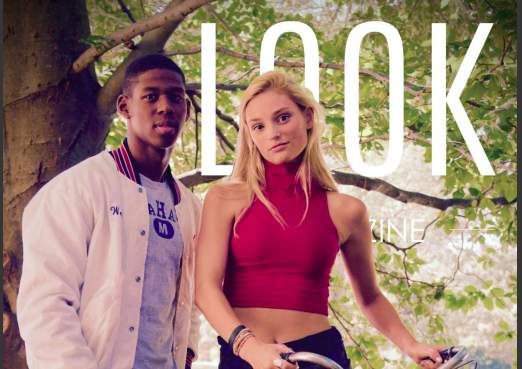The summer before my first year at Conn, I performed a thorough cleaning of my childhood bedroom. As I ventured underneath my twin bed, I was confronted by the inevitable collection of childhood relics. My collection included series of annual New York based fashion magazines. Over the years, I had accumulated a diversified set of haute couture magazines from Bergdorf Goodman to Crew Cuts. My 10 year-old self worshipped the ideals portrayed in these magazines. They represented a highly exclusive carefree lifestyle—that of the white and wealthy concealed by 1,200 dollar jeans and 4,000 dollar tote bags. Coupled with the increasing business of daily life and a maturing outlook on societal culture, I stopped the monthly acquiring and quotidian readings of my collection at the age of 13. I realized the types of people depicted in these magazines were unlike me: a chubby, average height, black girl. Over the summer, I threw out my magazine collection. But recently, as I scrolled through my Facebook feed and encountered theLOOK’s first 2017-2018 issue, I conjured up sentiments comparable to those of my summer clean up.
During the college admissions process, institutions advertise diverse student demographics, which are soon visually dismantled upon a student’s arrival, and Conn is no different. Until I arrived at Conn, I was isolated from the realities of “Conn diversity.” When I chanced upon theLOOK, I was frustrated with the singular black person plastered on the front cover and the seemingly endless photos of white cis-gender individuals and heterosexual couples in the magazine’s contents. Recognizing the noticeable tokenism, I immediately became angered with the contributors to the publication. TheLOOK pushed me off the edge, but given Conn’s current demographics, should I have expected anything less?
TheLOOK co-editor in chief, Yoldas Yildiz ’18, referenced experiences similar to mine when he he told me about the fashion magazines he viewed during his adolescence. Yildiz frequented magazines like GQ and Vogue. GQ, a notoriously poor representation of inclusivity, is marked with the exclusive and unattainable lifestyles of the white, wealthy, heterosexual, cis-gender man. When asked about his reaction to those magazines, his response paralleled mine, as he defined these highly acclaimed fashion magazines as “warped senses of beauty.” The disconnects between his experience and those portrayed in magazines forced him to become more creative when purchasing clothes. In managing increasing societal ideals, he separated himself from constructed notions and fostered an individualized vision of what beauty meant to him. As we began conversing about his first executive publication, I noticed that his replies contrasted the displays depicted in the recent issue. When asked about the influences of current societal stigmas on the fashion industry he replied, “There is so much creativity that isn’t western and eurocentric, but the industry shuts itself off from creative minds and people.” I agreed, but opening the Conn community to other creative minds did not seem to be the intentions of this season’s magazine.
If you haven’t yet seen the magazine, I suggest you take a look and formulate your own opinions. The magazine is separated into a series of fall trends, a dorm room review, profiles on model life, and two photoshoots: “The Class of 1985” and “Mystic Pizza.” The Mystic photoshoot is a rendition of the 80’s movie Mystic Pizza, which features six heterosexual white-passing couples. In a small blurb prior to the initial photoshoot, theLOOK says they chose couples that “closely resembled the movie’s main character.” But why? A rendition is defined as a performance or interpretation; accordingly, if the Mystic photoshoot was supposed to be an interpretation of a movie created 29 years ago, it should have been altered to the realities of our current society, not the society of the previous century.
I believe Conn publications have the power to negate ideals regarded as truths in our society. They are given the ability to relay broad-minded notions to our environment, so when students are placed outside of this secluded community, we sustain progressive visions from our years at Conn. Instead, theLOOK falls victim to the majority standpoint on what beauty is. While Yildiz did acknowledge that the current issue is not diverse, he went on to attest that “Sometimes we [at theLOOK] just forget” to incorporate diversity, a concept which I found particularly disturbing. As a member of a marginalized group, I do not want or intend to be forgotten.
This notion of “forgetting” diversity is not just embedded within the pages our campus fashion magazine. We see it everywhere, so how can we not be influenced by it? In 2016, the CFDA (Council of Fashion Designers of America) released statistics that 32% of models from runway shows and model castings in New York were non-white. A significant increase from 2008’s 13% non-white statistic, the increased percentage represented significant changes being fostered in the trade. In recent years, the industry has been making significant milestones; Jillian Mercado, a young woman with muscular dystrophy appeared in Beyonce’s apparel line, Ivy Park, and Madeline Stuart, a runway model with down syndrome, recently started her own apparel line titled “21 reasons why by Madeline Stuart.” With time, these recent industry changes will be normalized in our society.
Contrary to its current proceedings, theLOOK executes a seemingly objective recruitment process to attract Conn models. The magazine’s model selection board utilizes social media forums and on occasion approaches students from the exterior sitting area of Blue Camel. Students are also strongly encouraged to contact the magazine if they want to appear in an issue. In improving and diversifying the upcoming issue, Yildiz and his fellow co-editor in chief, Grace Carapezzi ’18, have plans to reach out to other campus clubs and organizations like Unity House and sports teams for collaborations. TheLOOK editors and staff are aware of diversifying the magazine, but we just can’t let them forget.









